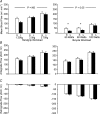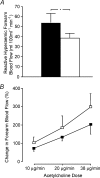Effect of exercise training on endothelium-derived nitric oxide function in humans
- PMID: 15375191
- PMCID: PMC1665322
- DOI: 10.1113/jphysiol.2004.068197
Effect of exercise training on endothelium-derived nitric oxide function in humans
Abstract
Vascular endothelial function is essential for maintenance of health of the vessel wall and for vasomotor control in both conduit and resistance vessels. These functions are due to the production of numerous autacoids, of which nitric oxide (NO) has been the most widely studied. Exercise training has been shown, in many animal and human studies, to augment endothelial, NO-dependent vasodilatation in both large and small vessels. The extent of the improvement in humans depends upon the muscle mass subjected to training; with forearm exercise, changes are restricted to the forearm vessels while lower body training can induce generalized benefit. Increased NO bioactivity with exercise training has been readily and consistently demonstrated in subjects with cardiovascular disease and risk factors, in whom antecedent endothelial dysfunction exists. These conditions may all be associated with increased oxygen free radicals which impact on NO synthase activity and with which NO reacts; repeated exercise and shear stress stimulation of NO bioactivity redresses this radical imbalance, hence leading to greater potential for autacoid bioavailability. Recent human studies also indicate that exercise training may improve endothelial function by up-regulating eNOS protein expression and phosphorylation. While improvement in NO vasodilator function has been less frequently found in healthy subjects, a higher level of training may lead to improvement. Regarding time course, studies indicate that short-term training increases NO bioactivity, which acts to homeostatically regulate the shear stress associated with exercise. Whilst the increase in NO bioactivity dissipates within weeks of training cessation, studies also indicate that if exercise is maintained, the short-term functional adaptation is succeeded by NO-dependent structural changes, leading to arterial remodelling and structural normalization of shear. Given the strong prognostic links between vascular structure, function and cardiovascular events, the implications of these findings are obvious, yet many unanswered questions remain, not only concerning the mechanisms responsible for NO bioactivity, the nature of the cellular effect and relevance of other autacoids, but also such practical questions as the optimal intensity, modality and volume of exercise training required in different populations.
Figures



Similar articles
-
Exercise and the nitric oxide vasodilator system.Sports Med. 2003;33(14):1013-35. doi: 10.2165/00007256-200333140-00001. Sports Med. 2003. PMID: 14599231 Review.
-
Regulation of coronary blood flow during exercise.Physiol Rev. 2008 Jul;88(3):1009-86. doi: 10.1152/physrev.00045.2006. Physiol Rev. 2008. PMID: 18626066 Review.
-
Vascular nitric oxide: effects of physical activity, importance for health.Essays Biochem. 2006;42:119-31. doi: 10.1042/bse0420119. Essays Biochem. 2006. PMID: 17144884 Review.
-
Effect of different intensities of exercise on endothelium-dependent vasodilation in humans: role of endothelium-dependent nitric oxide and oxidative stress.Circulation. 2003 Aug 5;108(5):530-5. doi: 10.1161/01.CIR.0000080893.55729.28. Epub 2003 Jul 21. Circulation. 2003. PMID: 12874192
-
Vascular nitric oxide and oxidative stress: determinants of endothelial adaptations to cardiovascular disease and to physical activity.Can J Appl Physiol. 2005 Aug;30(4):442-74. doi: 10.1139/h05-133. Can J Appl Physiol. 2005. PMID: 16258183 Review.
Cited by
-
Coronary vasomotor responses to isometric handgrip exercise are primarily mediated by nitric oxide: a noninvasive MRI test of coronary endothelial function.Am J Physiol Heart Circ Physiol. 2015 Jun 1;308(11):H1343-50. doi: 10.1152/ajpheart.00023.2015. Epub 2015 Mar 27. Am J Physiol Heart Circ Physiol. 2015. PMID: 25820391 Free PMC article.
-
Weight Loss and obstructive sleep apnea: what lies AHEAD?Sleep. 2013 May 1;36(5):627-9. doi: 10.5665/sleep.2608. Sleep. 2013. PMID: 23633741 Free PMC article. No abstract available.
-
Exercise, Cardiovascular Health, and Risk Factors for Atherosclerosis: A Narrative Review on These Complex Relationships and Caveats of Literature.Front Physiol. 2020 Jul 31;11:840. doi: 10.3389/fphys.2020.00840. eCollection 2020. Front Physiol. 2020. PMID: 32848823 Free PMC article. Review.
-
Whole Body Vibration Training Has No Effect on Vascular Endothelial and Inflammatory Markers in Young Healthy Women.J Clin Med. 2024 Jul 19;13(14):4228. doi: 10.3390/jcm13144228. J Clin Med. 2024. PMID: 39064268 Free PMC article.
-
Effects of isometric handgrip training dose on resting blood pressure and resistance vessel endothelial function in normotensive women.Eur J Appl Physiol. 2013 Aug;113(8):2091-100. doi: 10.1007/s00421-013-2644-5. Epub 2013 Apr 16. Eur J Appl Physiol. 2013. PMID: 23588257 Clinical Trial.
References
-
- Adams V, Hambrecht R, Erbs S. Impact of physical exercise training on the expression of NAD(P)H-oxidase and angiotensin-II receptors in the left mammarial artery of patients with coronary artery disease. Circulation. 2002;106:II-354. abstract.
-
- Al Suwaidi J, Hamasaki S, Higano S, Nishimura R, Holmes D, Lerman A. Long-term follow-up of patients with mild coronary artery disease and endothelial dysfunction. Circulation. 2000;101:948–954. - PubMed
-
- Ambring A, Benthin G, Petersson A-S, Jungersten L, Wennmalm Å. Indirect evidence of increased expression of NO synthase in marathon runners, and upregulation of NO synthase activity during running. Circulation. 1994;90:I-137. abstract.
-
- Arcaro G, Zamboni M, Rossi L, Turcato E, Covi G, Armellini F, Bosello O, Lechi A. Body fat distribution predicts degree of endothelial dysfunction in uncomplicated obesity. Int J Obesity. 1999;23:9936–9942. - PubMed
Publication types
MeSH terms
Substances
LinkOut - more resources
Full Text Sources
Other Literature Sources
Medical

